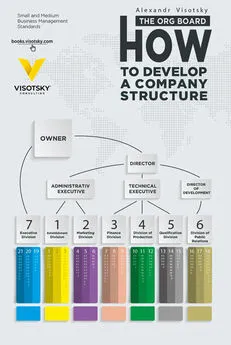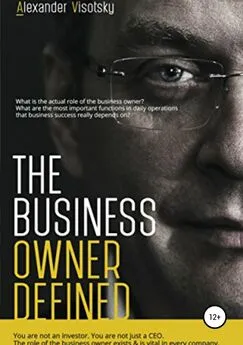Александр Высоцкий - The org board. How to develop a company structure
- Название:The org board. How to develop a company structure
- Автор:
- Жанр:
- Издательство:неизвестно
- Год:неизвестен
- ISBN:нет данных
- Рейтинг:
- Избранное:Добавить в избранное
-
Отзывы:
-
Ваша оценка:
Александр Высоцкий - The org board. How to develop a company structure краткое содержание
The org board. How to develop a company structure - читать онлайн бесплатно ознакомительный отрывок
Интервал:
Закладка:
Александр Высоцкий
The org board. How to develop a company structure
Introduction
This book was written for the executives and owners of small to medium sized companies that are expanding, as well as anyone who makes decisions regarding the company’s structure and improvements to facilitate business growth and development. It is for those who love what they do and dream of creating a well-organized business.
When I was creating my first business, I was going through one textbook after another on the subject of management in an attempt to find the answer to this question: what is the optimum structure for my company? Without any exaggeration, I spent lots of hours researching but, in the end, was disappointed. In management textbooks I found only very general recommendations, most of which did not go beyond classifying types: the company structure can be of this type, or it can be of that type… I did not find any specific concepts regarding which structure I should choose and what criteria I should use to make that choice. Also, while reading these books, I got the impression that they are written as if one wanted to manage some global corporation from aboard a spacecraft. It was impossible to understand how to apply all these clever ideas to actual operations in a relatively small manufacturing, trading or service company.
I also knew that I would not be able to build a well-managed company if I, the founder and the CEO, didn’t have an initial "blueprint", basically – no idea of the necessary divisions and levels of employee responsibility. At that time, my manufacturing company was not very big. It had about 150 full-time employees and several independent contractors. My technical education, logic, and experience told me that without a sound organizational structure I would not be able to properly organize and expand the work, just as it would be impossible to build a beautiful building by attaching additional floors, attics, balconies, and garages to a small house. Only with a comprehensive initial plan of the entire building could it be built floor by floor.
As it turned out, this problem had a beautiful and logical solution. It is possible to develop a structure that will provide a solid foundation for organizational expansion and development, while will not changing significantly in the process of growth. As I write this, seven years of consulting and working experience with more than two hundred companies of various specializations confirm that this is not just an elegant theory. It is a real opportunity to create an optimum structure of the company, regardless of its size and stage of business development.
This book is dedicated to one of the fundamental principles of organizing work, which you will use to overcome management difficulties. Regardless the size of your company, while reading this book you will see the great potential of your business as well as the issues which limit its growth and development. You may think you already know this, but I'll take it upon myself to say that you are mistaken. If you already knew precisely the true potential of your company, and understood its weakest link – you would have already taken care of it.
I often hear from business owners that their weak spot is sales, but experience shows otherwise. Cursory research shows that sales departments function quite well, while instead management is completely oblivious to lack of advertising, or that their products are not competitive. Regardless of whether you agree or not, I promise that you will see your business in a completely new light and gain many new ideas for its expansion.
If you look around, you will find many companies in many different lines of business that have great products, but the scale of their activities has not grown for years. Why do some companies expand rapidly and within ten years go international, while others, despite their outstanding product, settle for a very small share of the market and remain at almost the same level? You will find the answer to this question in my book.
Perhaps, you will thumb through this book and see some data that seems redundant or too complex. However, if you read it consistently and carefully, you will see that these concepts are simple and useful, even for small companies. Their implementation will bring any sized business significant expansion.
After all, your personal point of view on your business fully determines its future. My recommendation is that you read this book in its entirety, and then refer to individual chapters and inserts to gain a greater understanding of specific divisions.
Management is one of the most ancient human endeavors. It can remain simple if you don’t introduce arbitrary complexities. Its basics have remained virtually unchanged since the times when the head of the tribe led his tribesmen out of the caves to hunt mammoths. Of course, modern technology (computers, the Internet, advanced means of communication, etc) gave us an opportunity to eliminate errors from daily tasks, but the basics of managing a group remain the same.
These basics will give you the knowledge to better understand how you can organize a group of people and their work. An adventure is awaiting you. After reading this book you will see your own business and any other company in a different light.
Chapter 1
Stages of development and crises of the small business
A company goes through several stages in its development; it all starts with the bright idea that answers how you can provide something of value to a certain category of customers.
We can say that this is the research and development phase of a product and its reproduction. In some business fields areas, such a technology already exists or can be acquired; while with others you have to invent or create something new.
At this stage, the company’s founder is often deeply involved with the daily activities of the company and product development. He personally organizes production or arranges delivery of goods. He thoroughly explores and implements the vision of a restaurant, or develops the services for the company. If this stage is successful, it’ll result with the first batch of satisfied customers, and your team gains the confidence that your idea translates to a business. This stage one understands the product’s actual cost, prices are developed and connections are created to get the necessary resources. The product undergoes some improvements or even a complete makeover, and you gain an insight, confirmed by experience, into your customers and distribution channels. At this stage, the company executives are not quite interested in making management as effective as it could be – all the attention is focused on product creation and bolstering a viable company.
We call this the Manual Stage, where the business founder, holding the vision and being competent, manages a small team quite well. He knows the technology for producing the product, as well as what his employees need to achieve in order to get results. As the company engages in small-scale activity, there aren’t executives and management issues do not come up. Regardless, the business is still gradually approaching the First Management Crisis. When the company hits the crisis depends on how fast the company is growing.
Once the idea proves successful and you have to turn it into a real business, then we move to the next stage. The owner begins to understand that to further expand, he needs to shift from directly managing individual employees to managing parts of the company – he needs to create a second level of managers. Whether the business owner promotes his best employees to managers or tries to hire experienced ones, the First Management Crisis deals the inevitable blow. After managers or executives are hired and established, overall efficiency usually drops.
CEOs of smaller companies come to a seemingly logical conclusion that the drop is due to the incompetence of his new hires or their unwillingness to work. Have you ever heard executives complain about employees who don't want to work? Yet, these same employees had previously produced good results under direct management – and suddenly everything changed.
The real reason is not that people transform overnight, but that the leader- usually, the owner of the company – is only good at directly managing rank and file employees and not his new level of executives. The owner knows the production technology and competently directly guides employees to the desired results. The owner is just not able to effectively manage the executives who must now manage the other employees. It's one thing to fly a plane, which in itself is not an easy task and requires special skills, but it’s a completely different job to lead a team of pilots. A pilot has to competently handle the machine, an executive needs to competently handle people. Additionally, they use completely different bodies of knowledge and tools.
This is the main reason why small and profitable companies, even those with great products, rarely expand beyond a certain point. They weren’t able to overcome the First Management Crisis and grow out of their small business "pants". Thousands of examples illustrate the First Management Crisis. One of the most famous is the incredibly successful small family restaurant owned by brothers Dick and Mac McDonald. It was well known locally and produced a steady income for its owners. The brothers made numerous attempts to create a network of fast food restaurants, but it wasn’t until Ray Kroc [1] Ray Kroc: Raymond Albert "Ray" Kroc (October 5, 1902 – January 14, 1984), an American entrepreneur, restaurateur and owner of McDonald's corporation. He was included by Time magazine in the "100 most important people of the century" list. He amassed a fortune valued at $500 million at the time of his death.
took on the business development that McDonald’s was born.
A lesser known, but no less illustrative example is that of the famous Brooklyn pizzeria Di Fara Pizza who has had the same owner and chef, Domenico DeMarco [2] Domenico DeMarco: the founder and chef at Di Fara Pizza, a pizzeria in Brooklyn, a borough of New York City. The facility opened in 1964. The New York Times called the restaurant: "one of the most acclaimed and sought-after pizza shops in New York City". This pizzeria is known for its great tasting pizza, noted by New York magazine, online publication Serious Eats, Zagat rating company, and Frommer's travel guides.
, since 1964.
Experts have repeatedly honored DeMarco’s pizza with the highest awards. Yet, despite the outstanding taste and a long line of people outside the restaurant, the facility has not expanded since its opening. Of course, this situation greatly depends on the goals of the business founder. In this example the owner simply doesn’t desire to expand his business. His passion lies in the craft and it seems that he simply likes making pizza without any further ambitions. To get to the next stage of business development, one needs to have the ambition to grow and have big goals. Then there is a chance to overcome this crisis. In my book, The Business Owner Defined, I described, in detail, the objectives of a business. However, to become successful, it is not enough to just have goals for the company executives. There has to be tools, such as a company structure, a system to measure results, financial policies, etc.
A business falls into the First Management Crisis after appointing executives without any management tools. These executives expect the owner to utilize the same hands-on control, but in a more difficult condition as the company has grown. Additionally, the owner now tries to manage "manually" at a new level, which is usually unsuccessful, and so the chaos grows. In order to overcome the crisis, the founder of the company must master the tools for managing people, train strong leaders, and learn to manage effectively.
Читать дальшеИнтервал:
Закладка:










